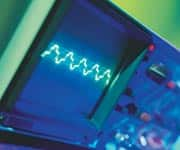Life Extension Magazine®
Q: I am a 55-year old woman in excellent health. Because my mother suffered a fatal heart attack at the age of 60, I asked my primary care doctor about my risk for heart disease. My doctor suggested that I speak with a cardiologist. Which tests should I request as part of a complete cardiac work-up, and what is the rationale for each test? A: This is a very common dilemma: how to detect silent heart disease and the potential for a heart attack in someone in apparent good health and without symptoms such as chest discomfort or breathlessness. Unfortunately, it is an area of great confusion, even among cardiologists. A common sequence of testing is to obtain an electrocardiogram (EKG), exercise stress test, and cholesterol (lipid) panel. Your doctor may also ask you about cardiac risk factors such as smoking, high blood pressure, diabetes, and family history. How successful is this approach to detecting hidden heart disease? It fails to identify even advanced levels of heart disease in over 90% of people! By overwhelming majorities, future heart attack victims have normal EKGs, pass a stress test without a hitch, and have average cholesterol values. That is why most heart attacks, as well as the need for major heart procedures like bypass surgery, come as a complete surprise to both patient and doctor.1,2 Former President Bill Clinton provides a perfect example of the failings of the conventional approach to detecting heart disease. Mr. Clinton, an avid jogger, underwent a stress test annually for five years, and used Lipitor®, the popular, cholesterol-lowering prescription medication. With little warning, Mr. Clinton nearly collapsed, prompting a visit to the emergency room at New York-Presbyterian Hospital, where he was found to have severe, advanced coronary disease. Mr. Clinton’s care was hailed as a glowing example of the success of high-tech medical procedures. To the contrary, Mr. Clinton’s need for bypass surgery serves as an example of the enormous failure of his doctors to detect a disease that requires decades to develop. How can you learn from the millions of people like Mr. Clinton who are misled by the false reassurances provided by conventional testing? Three tests stand out as superior ways to uncover hidden heart disease or the potential for future catastrophe: CT (computed tomography) heart scans, lipoprotein testing, and the ankle-brachial index. CT Heart ScansThis 30-second test easily and accurately measures hidden coronary plaque by assessing arterial wall calcium. Calcium occupies 20% of the volume of all plaque that can line the coronary arteries. Measuring calcium can therefore be an easy, safe method of quantifying total plaque. The more plaque you have, the greater your risk for heart attacks. Critics have suggested that this test measures only “hard,” or stable, plaque. This is untrue. The CT heart scan measures total plaque, including hard, stable plaque and the “soft,” less stable plaque that is more likely to trigger a heart attack. The result is reported to you as a “score”; higher scores indicate more plaque is present.3-5 (More information on the significance of various scores, as well as a listing of all heart scanners in the US, can be found at www.trackyourplaque.com.) Had Mr. Clinton undergone a heart scan several years before he required bypass surgery, his doctors may have uncovered a high score of greater than 400, or possibly even one measured in the thousands (a normal score is zero). This information may have allowed Mr. Clinton and his physicians to implement a powerful program to help prevent or reverse heart disease and avert the need for future cardiac procedures. Unfortunately, few hospitals routinely offer preventive strategies such as the CT heart scan, instead focusing on major cardiac procedures to treat life-threatening catastrophes. Lipoprotein TestingA standard cholesterol panel, or lipid panel, assesses LDL (low-density lipoprotein), HDL (high-density lipoprotein), triglycerides, and total cholesterol. A far more intensive and revealing test is lipoprotein testing, an analysis that examines fat-carrying proteins in the blood. In addition, several non-lipid blood tests can uncover other sources of cardiovascular risk.
Many people who have had heart attacks or major heart procedures are told that no cause can be identified for their disease, or that they have genetic, and therefore untreatable, causes. Both statements are patently untrue. In fact, lipoprotein testing identifies the causes of heart disease in 98% of people, even in people with favorable cholesterol values.6-9 Lipoprotein and other advanced testing can be obtained in several ways. (For more information, see “Cholesterol and Statin Drugs: Separating Hype from Reality,” Life Extension, November 2004.) Your doctor can order and interpret these tests for you, as well as provide advice on treatment. The panel we obtain in patients who are interested in detecting and regressing (reversing) coronary disease includes: Lipoprotein testing
Other testing
Ankle-Brachial IndexThe ankle-brachial index is a reliable, inexpensive, and non-invasive assessment that can indicate the presence of peripheral arterial disease, a condition in which the arteries of the extremities become progressively occluded by plaque, leading to reduced blood flow. Because peripheral arterial disease is a manifestation of the atherosclerotic process, this test can also help assess cardiovascular and cerebrovascular disease risk, as well as overall mortality risk.10 The ankle-brachial index compares blood pressure values at the arm and ankle, both at rest and following light exercise. The ankle-brachial index is calculated by dividing the highest blood pressure at the ankle by the highest recorded pressure at the arm. This measure correlates well with disease severity and functional symptoms.11 A normal resting ankle-brachial index is 1.0 or 1.1. Values below 0.95 suggest decreased blood flow in the legs, and values of 0.25 and below suggest severe peripheral arterial disease.12 Emerging evidence suggests that the ankle-brachial index is related to the extent of atherosclerosis in both the heart and the peripheral arterial beds.13 One study demonstrated that an ankle-brachial index of less than or equal to 0.90 was strongly correlated with atherosclerosis of three or more coronary vessels, or severe coronary artery disease.14 In this study, however, a normal ankle-brachial index did not predict the absence of one- or two-vessel coronary artery disease.14 Further studies confirm that a lower ankle-brachial index value is associated with a higher prevalence of coronary artery disease of three or four vessels.15 An ankle-brachial index of less than 0.90 has been found to be an independent predictor of cardiovascular events after adjustment for age, LDL (low -density lipoprotein), and carotid intima-media thickness.13 The ankle-brachial test appears to be especially indicated to help stratify cardiovascular risk in individuals with multiple cardiovascular risk factors.16 The ankle-brachial index thus provides another valuable tool for those seeking to assess cardiovascular risk and uncover silent cardiovascular disease. Using CT heart scanning in combination with lipoprotein testing and the ankle-brachial index is an easy, painless, and powerful approach to detecting heart disease and its risk factors. While no test is perfect, this approach can identify 95-98% of all hidden coronary heart disease. Of course, additional tests should be considered, depending on the findings of a physical examination, standard laboratory assessment, and history. Including a CT heart scan, lipoprotein testing, and ankle-brachial index assessment in your assessment will ensure that you obtain accurate insight into your risk for heart disease. Editor’s Note: While the computed tomography (CT) heart scan is a valuable diagnostic tool, it is also a potent X-ray that emits a significant amount of radiation. Life Extension has long warned that even small amounts of radiation carry health risks (see “Just Say No to X-rays!” Life Extension, October 2005). Although the CT heart scan may provide crucial information for individuals with suspected coronary heart disease, Life Extension believes that the radiation exposure is too great to warrant its use as a screening tool in otherwise healthy individuals. It may be prudent for asymptomatic individuals to evaluate their cardiovascular risk by first using testing methods that do not expose them to radiation, such as lipoprotein testing and the ankle-brachial index. Dr. Davis is an author, lecturer, and practicing cardiologist in Milwaukee, WI. He is author of the book Track Your Plaque: The only heart disease prevention program that shows how to use the new heart scans to detect, track, and control coronary plaque. Dr. Davis can be reached at www.trackyourplaque.com. | |||
| References | |||
| 1. Greenland P, LaBree L, Azen SP, Doherty TM, Detrano RC. Coronary artery calcium score combined with Framingham score for risk prediction in asymptomatic individuals. JAMA. 2004 Jan 14;291(2):210-5. 2. Fowler-Brown A, Pignone M, Pletcher M, Tice JA, Sutton SF, Lohr KN. US Preventive Services Task Force. Exercise tolerance testing to screen for coronary heart disease: a systematic review for the technical support for the US Preventive Services Task Force. Ann Intern Med. 2004 Apr 6;140(7):W9-24. 3. Budoff MJ. Atherosclerosis imaging and calcified plaque: coronary artery disease risk assessment. Prog Cardiovasc Dis. 2003 Sep-Oct;46(2):135-48. 4. Pletcher MJ, Tice JA, Pignone M, Browner WS. Using the coronary artery calcium score to predict coronary heart disease events: a systematic review and meta-analysis. Arch Intern Med. 2004 Jun 28;164(12):1285-92. 5. Raggi P, Berman DS. Computed tomography coronary calcium screening and myocardial perfusion imaging. J Nucl Cardiol. 2005 Jan-Feb;12(1):96–103. 6. Ginsberg HN. New perspectives on atherogenesis: role of abnormal triglyceride-rich lipoprotein metabolism. Circulation. 2002 Oct 15;106(16):2137-42. 7. Freedman DS, Otvos JD, Jeyarajah EJ, Barboriak JJ, Anderson AJ, Walker JA. Relation of lipoprotein subclasses as measured by proton nuclear magnetic resonance spectroscopy to coronary artery disease. Arterioscler Thromb Vasc Biol. 1998 Jul;18(7):1046-53. 8. Carmena R, Duriez P, Fruchart JC. Atherogenic lipoprotein particles in atherosclerosis. Circulation. 2004 Jun 15;109(23 Suppl 1):III2-7. 9. Blake GJ, Otvos JD, Rifai N, Ridker PM. Low-density lipoprotein particle concentration and size as determined by nuclear magnetic resonance spectroscopy as predictors of cardiovascular disease in women. Circulation. 2002 Oct 8;106(15):1930-7. 10. Federman DG, Bravata DM, Kirsner RS. Peripheral arterial disease. A systemic disease extending beyond the affected extremity. Geriatrics. 2004 Apr;59(4):26, 29-30, 32 passim. 11. Mohler ER 3rd. Peripheral arterial disease: identification and implications. Arch Intern Med. 2003 Oct 27;163(19):2306-14. 12. Available at: http://my.webmd.com/hw/health_guide_atoz/aa115638.asp. Accessed May 24, 2005. 13. Papamichael CM, Lekakis JP, Stamatelopoulos KS, et al. Ankle-brachial index as a predictor of the extent of coronary atherosclerosis and cardiovascular events in patients with coronary artery disease. Am J Cardiol. 2000 Sep 15;86(6):615-8. 14. Otah KE, Madan A, Otah E, Badero O, Clark LT, Salifu MO. Usefulness of an abnormal ankle-brachial index to predict presence of coronary artery disease in African-Americans. Am J Cardiol. 2004 Feb 15;93(4):481-3. 15. Sukhija R, Aronow WS, Yalamanchili K, Peterson SJ, Frishman WH, Babu S. Association of ankle-brachial index with severity of angiographic coronary artery disease in patients with peripheral arterial disease and coronary artery disease. Cardiology. 2005;103(3):158-60. 16. Igarashi Y, Chikamori T, Tomiyama H, et al. Diagnostic value of simultaneous brachial and ankle blood pressure measurements for the extent and severity of coronary artery disease as assessed by myocardial perfusion imaging. Circ J. 2005 Feb;69(2):237-42. |



